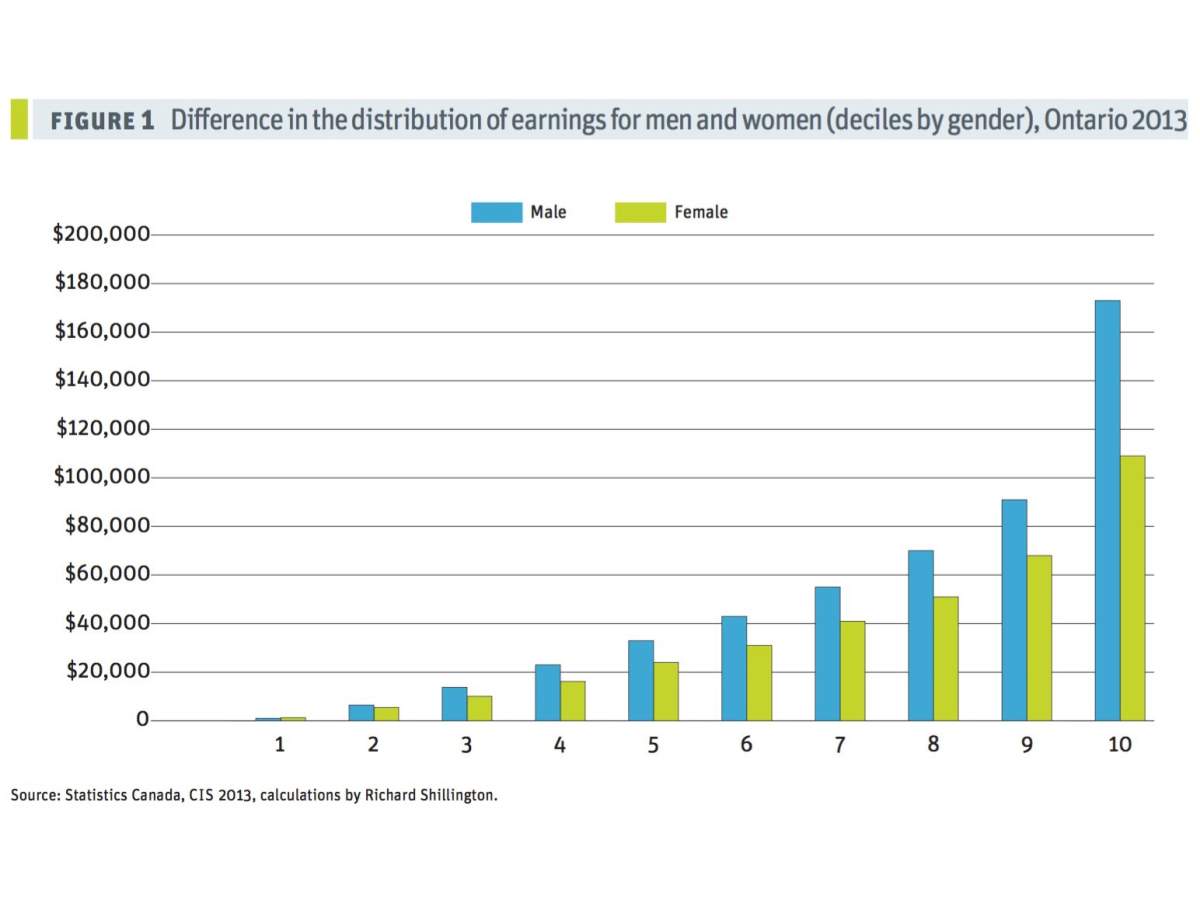Women in Canada continue to make less money than men for the same work. And it’s something that’s getting extra attention on this Equal Pay Day — a commemorative day set in mid-April to acknowledge that women would need to work an extra three-and-a-half months per year to earn the same as men do in 12 months.

According to raw Census data from 2016 that was compiled by the Ontario Equal Pay Coalition and the Canadian Centre for Policy Alternatives (CCPA), women in Ontario earn 29.3 per cent less than men. On average across the country, men earned an annual income of $51,900 in 2016 compared to women’s earnings of $36,000, resulting in a gap of $15,900 per year.
WATCH BELOW: Province hopes new ‘pay transparency’ legislation will help close gender pay gap

What’s more, racialized and Indigenous women earn even less. The same data shows that Indigenous women in Ontario face a 43 per cent gap, racialized women face a 38 per cent gap and immigrant women face a 34 per cent gap.
“The big picture of the wage gap is that it contributes to inequality, and reduces our fairness and trust in society,” Sheila Block, senior economist at the CCPA, tells Global News. “Women are important contributors to their family, whether that’s a family they’re forming with another woman, a man or as a single parent.”
In addition, it prevents impoverished women from lifting themselves out of poverty, and threatens their families and their future security.
“Lower earning power means women are at a high risk of falling into poverty, are less able to save for their retirement and are sometimes forced to make a choice between safety and staying in abusive relationships,” explains Paulette Senior, president and CEO of the Canadian Women’s Foundation.

Get daily National news
There are some variations in the pay gap that indicate a trend toward equality, although it depends on the industry and education level of workers, and typically applies to higher-wage jobs. For example, women who work in the STEM field (science, technology, engineering, mathematics), make 82 per cent of what their male counterparts earn.
READ MORE: Gender equality in Canada: Where do we stand today?
Data from 2015 shows that annual earnings for women aged 25 to 34 with a bachelor’s degree and who worked in STEM were earning $59,492 compared to $72,443 earned by men of the same age and with the same education.
What does that look like in hard numbers? In the second rung of earnings, where both men and women made under $20,000, women earned $1,000 less per year. Over a 35-year career, that adds up to $35,000 in lost wages for women.
As the rungs on the ladder climb, indicating jobs with higher annual salaries, the disparity grows. In the third and fifth steps, women earned $3,700 and $9,000 less (adding up to $129,500 and $315,000 in fewer wages over 35 years). But the greatest gap was at the top.
Women in the top salary bracket earned 37 per cent less than their male coworkers, resulting in a $64,000 annual disparity that over 35 years, amounts to $2,240,000 less earnings than men doing the same job.
The study also found that the gap is lowest in natural and applied science occupations, amounting to 11 per cent or $8,000 per year.
READ MORE: Ontario Liberals promise free preschool for all in 2020, but is that realistic?
“Part of that is arithmetic — if the numbers are larger, the gap is going to be larger in dollars,” Block says. “But the fact that the gap increases in percentage tells us a lot about inequality and how the benefits of the economy are unequally distributed and concentrated more for men. When we look at very high-income earners, they’re largely men, and women aren’t getting access to those opportunities.”
While the gender pay gap is a global issue, the fact that Canada ranks seventh out of 34 countries in the Organization for Economic and Co-operation Development for having the highest gap is disheartening.
“It’s a little bit shocking and shameful, and it shows that the government hasn’t taken the action required to reduce that gap,” Block says.
It would take a number of things to see the gap shrunken and even disappear, she explains. Research points to accessible childcare as the first and most important step, since the pay gap tends to widen and stay that way during a woman’s childbearing years. In addition, Block points to more pay transparency, as well as effective legislation that would enforce pay equity in the private sector.
Her sentiments are echoed by Senior: “We can help to eliminate the gender pay gap by addressing systemic inequality and strengthening legislation,” she tells Global News. “Pay transparency legislation, for example, can help employees expose when women and men are being paid differently for the same work.”
READ MORE: Childcare costs in Canada rose faster than inflation in 2017
Block says that the new childcare policy proposed by the Ontario Liberals to offer free childcare to children over the age of two would make a considerable difference, because it would allow women to get back on track of their careers and earning potential.
“If women have reduced access to opportunities, it reduces overall productivity in our economy,” she says. “We want to use everyone’s talents fully so that we can have a more productive and fair economy all around.”











Comments